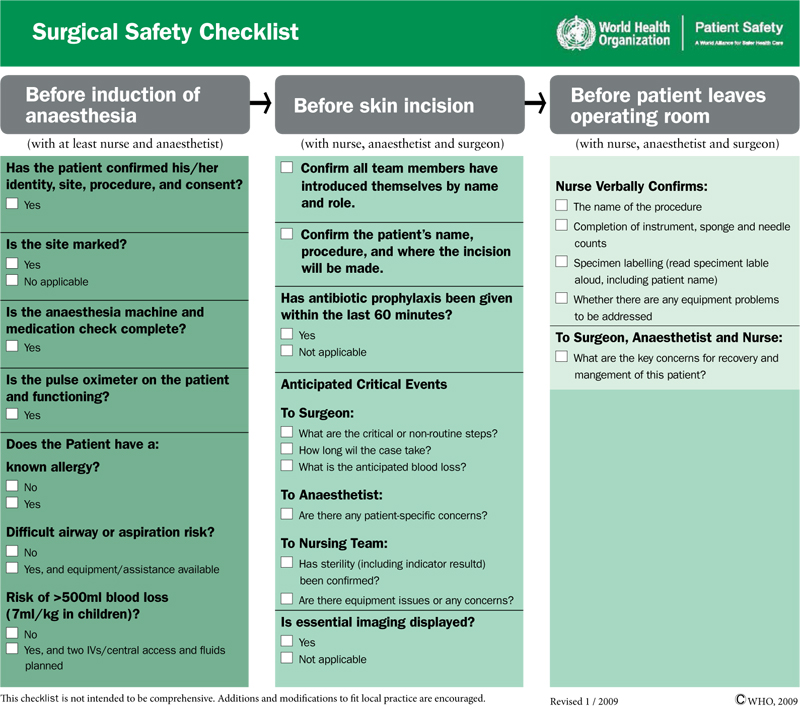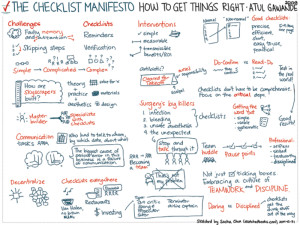A checklist provides a frame work and initiates brief discussion about the case, expected difficulties and plan of action to deal with complication or difficult situations.
In the previous article, we discussed about human factors as one of the most important reasons for errors. An individual is aware of his/her immediate surroundings but not about the larger surroundings. This is called as “situational awareness”.
A person may do his/her job diligently, but when it comes to synchronous activity of different departments or different persons there is always a potential for error. When two people with different background information start functioning together, there is bound to be a gap. When few actions, having no logical sequence, have to be done in synchronized manners, the chance of something getting missed is high. Think of a memory test where few different objects are flashed in front of you and you are asked to memories them. It is a high possibility that you may forget some of them, if not, you will not recollect them in the same order!
When checklists come into play
Checklists find their way in such situations. Actually checklist is not a new concept at all. Do we not make a “To Do list”? However, the institutionalization of the checklist has an interesting history. In 1935, U.S. Military had organized an exhibition cum-competition for aircraft manufacturers. Boeing, the famous aircraft manufacturer was also in the competition. Model 299 of Boeing was very advanced and could carry five times more bombs than expected by the US military. The competition was a mere formality by Boeing. Major Hill, a very experienced pilot and trainer was given the job to fly the aircraft on that day. Model 299 took off smartly. The aircraft reached the height of around 300 feet height and suddenly tilted to one side. Within few seconds it collapsed to the ground and caught fire. Major Hill lost his life. After this unexpected accident, a fact finding committee was constituted. The committee concluded that there was no technical fault in the aircraft. The pilot was at fault! How could an experienced pilot commit such a blunder? That took a blunder that could cost his own life? Later, it was realized that the systems of the aircraft were quite complicated. Actually, the pilot was supposed to perform a number of tasks within a small period of time in a synchronous manner. And Major Hill had simply forgotten to perform one out of them!
Although Boeing lost the competition, American Military decided to try out few aircrafts. Realising the complexity in flight operation, they came up with a checklist of the size of a postcard! The checklist actually enlisted mundane tasks that a pilot should do while taxing, taking off and landing. After implementing the checklist, Model 299 travelled 1.8 million miles without a single accident. This aircraft played a significant role in the Second World War.

The Safe Surgery Checklist project
 Dr. Atul Gawande, a noted surgeon from the USA depicted this history beautifully in his book “The Checklist Manifesto”. It was under his leadership that the WHO initiated the “Safe Surgery Checklist” project. A simple checklist created by them had three pause points; first one before giving anaesthesia, next before beginning the surgery, and the last one was at the end of the surgery. This checklist was implemented in 8 hospitals and 4,000 surgeries. Highly equipped hospitals in developed countries and poor hospitals from under-developed and developing countries were a part of the project. The results were brilliant! The mortality and morbidity was reduced by a whopping 35%! How did this happen? What was the secret? Was it just a piece of paper that made this trick?
Dr. Atul Gawande, a noted surgeon from the USA depicted this history beautifully in his book “The Checklist Manifesto”. It was under his leadership that the WHO initiated the “Safe Surgery Checklist” project. A simple checklist created by them had three pause points; first one before giving anaesthesia, next before beginning the surgery, and the last one was at the end of the surgery. This checklist was implemented in 8 hospitals and 4,000 surgeries. Highly equipped hospitals in developed countries and poor hospitals from under-developed and developing countries were a part of the project. The results were brilliant! The mortality and morbidity was reduced by a whopping 35%! How did this happen? What was the secret? Was it just a piece of paper that made this trick?
In the operation theater different people work round the clock. In large and busy hospitals, the surgeons, anaesthetists, nurses may not even know each other. It is expected that people who do not know each other should work as a cohesive team. As a part of the checklist, every member of the team is supposed to introduce himself/herself to others and also to the patient. The checklist provides a frame work and initiates brief discussion about the case, expected difficulties and plan of action to deal with complication or difficult situations. It ensures that the team collectively goes through tasks and checks all vital things each and every time.
After this inspiring experiment, many hospitals in the world have started creating and using these pieces of paper called checklists. Some are overzealously creating checklists for anything and everything under the Sun! But the same results are not reproducible. Reason: the lack of training and acceptance of patient safety ideology. In some hospitals, the items are simply ticked because they have to be ticked. Many doctors and nurses look at the checklist as “one more fad”. For them it is one more clerical formality that has to be done. In fact, the WHO has uploaded an interesting video titled “How not to do the checklist” (https://www.youtube.com/watch?v=DOGJMOMHDJk)
When is a checklist most useful?
It is also important to understand how to make a checklist. Checklists will be most useful when unconnected people have to carry out activities or tasks, which have no logical sequencing but the tasks have to be done in a synchronized manner. These tasks should not be “discretionary in nature”. To quote an example, “giving antibiotics prior to surgery” is a task where there is no discretion. But choosing an antibiotic will involve discretion. Once the subject for the checklist is decided, one should write down the complete process or do process mapping. The next step is to identify the relevant pause points. These pause points must be crisply described. One must give importance to practical situations such as the place where a particular task is actually completed. At every pause point, one should have no more than 8 to 10 items. The items on the checklist have to be read by one person and checked by another. To break the hierarchy, it is advisable that the junior person asks the question and the senior confirms it. Patient Safety Alliance has made one such checklist for patients when they get admitted at the hospital, it can be accessed at:
http://patientsafetyalliance.in/wpcontent/uploads/2014/06/workshop-tools-4.pdf
